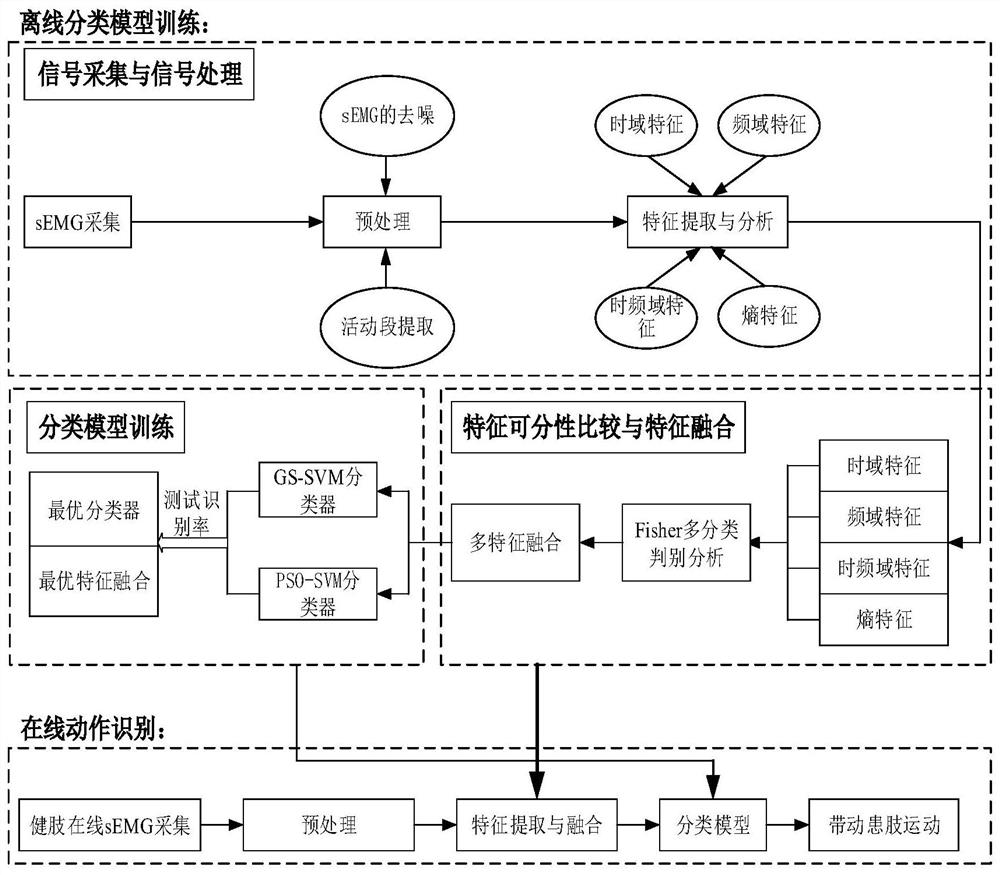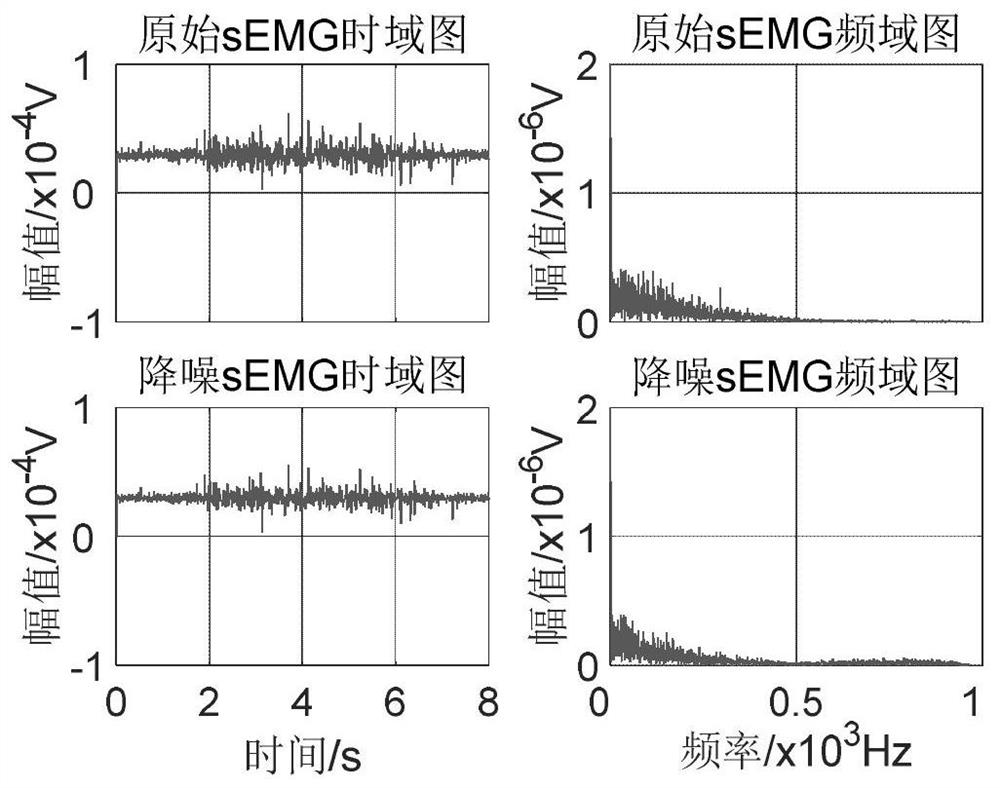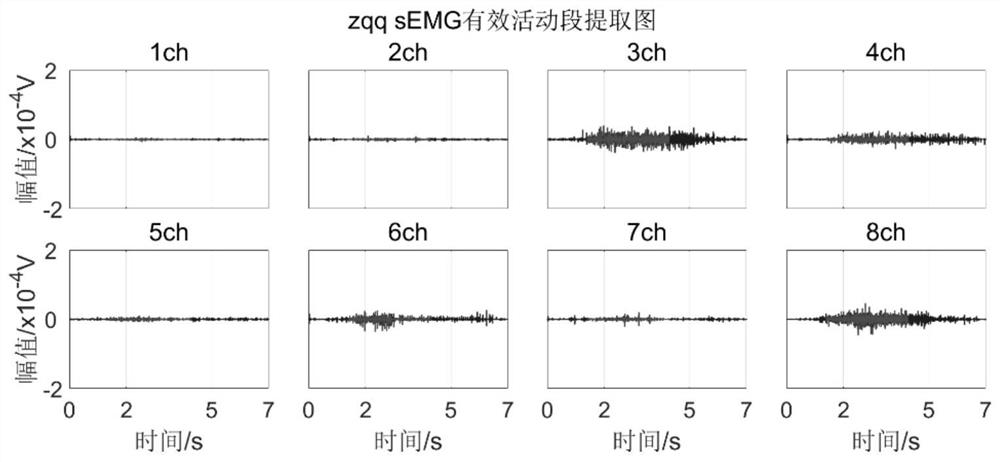Upper limb movement recognition method and system based on surface electromyogram signals
A technology of electromyographic signal and motion recognition, applied in the field of motion recognition, can solve the problems of increasing the amount of data and signal processing complexity, reducing the rate of motion recognition, and the number of types of recognized motions, etc., to reduce data redundancy, improve accuracy, The effect of reducing the delay time
- Summary
- Abstract
- Description
- Claims
- Application Information
AI Technical Summary
Problems solved by technology
Method used
Image
Examples
Embodiment 1
[0057]This embodiment discloses an upper limb movement recognition method based on surface electromyography signal multi-joint continuous movement, which can use 8-channel sEMG signals to accurately identify shoulder level adduction / abduction, elbow flexion / shoulder extension, elbow inward 14 kinds of upper body movements such as retraction / abduction, elbow flexion / extension, wrist adduction / abduction, wrist flexion / extension, fist clenching / stretching fist, etc. The method includes an offline classification model training stage and an online action recognition stage, such as figure 1 shown.
[0058] (1) Offline classification model training stage
[0059] Step 1: Obtain multiple muscle EMG signals corresponding to various upper limb movements as a training data set.
[0060] In this embodiment, the EMG sEMG signals of 8 muscles were collected when 8 subjects performed 14 kinds of upper limb movements: deltoid muscle, pectoralis major, biceps brachii, flexor carpi radialis, ...
Embodiment 2
[0160] The purpose of this embodiment is to provide an upper limb motion recognition system based on surface electromyographic signals.
[0161] An upper limb movement recognition system based on surface electromyographic signals, comprising:
[0162] The signal acquisition module acquires the myoelectric signals of multiple muscles of the upper limb;
[0163] The signal preprocessing module performs denoising preprocessing on the EMG signal, and extracts the active segment signal in the EMG signal based on the frame energy method;
[0164] The feature extraction module performs feature extraction on the active segment signal according to the optimal feature fusion method;
[0165] The feature fusion module fuses the extracted features;
[0166] The action recognition module uses the SVM classifier for action recognition according to the fused features.
Embodiment 3
[0168] The purpose of this embodiment is to provide an electronic device.
[0169] An electronic device, comprising a memory, a processor, and a computer program stored on the memory and operable on the processor, when the processor executes the program, the following steps are implemented, including:
[0170] Obtain EMG signals from multiple muscles in the upper limbs;
[0171] Based on the sub-frame energy method, the active segment signal in the EMG signal is extracted;
[0172] Perform feature extraction and feature fusion on the active segment signal according to the optimal feature fusion method;
[0173] According to the fused features, the SVM classifier is used for action recognition.
PUM
 Login to View More
Login to View More Abstract
Description
Claims
Application Information
 Login to View More
Login to View More - R&D
- Intellectual Property
- Life Sciences
- Materials
- Tech Scout
- Unparalleled Data Quality
- Higher Quality Content
- 60% Fewer Hallucinations
Browse by: Latest US Patents, China's latest patents, Technical Efficacy Thesaurus, Application Domain, Technology Topic, Popular Technical Reports.
© 2025 PatSnap. All rights reserved.Legal|Privacy policy|Modern Slavery Act Transparency Statement|Sitemap|About US| Contact US: help@patsnap.com



